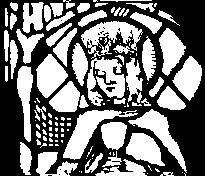Eadburh of Winchester
| Saint Eadburh of Winchester | |
|---|---|
 | |
| Died | 15 June 960 |
| Venerated in |
Anglican Communion Catholic Church Orthodox Church |
| Canonized | 972 |
| Feast | 15 June |
Saint Eadburh (or Edburga) (died 15 June 960) was the daughter of King Edward the Elder of England and his third wife, Eadgifu of Kent.
Life
In the twelfth century, a Latin Life of her was written by Osbert de Clare, who became prior of Westminster in 1136 (and who also wrote a Life of King Edward the Confessor).[1] According to Osbert, at the age of three, Eadburh was given as an oblate to the Queen Mother Ealhswith's foundation of St Mary's Abbey, Winchester (Nunnaminster). There Eadburh was educated and there she remained as a nun and died probably before the age of forty.[2]
There is little contemporary information for her life, but in a Winchester charter dated 939, she was the beneficiary of land at Droxford in Hampshire granted by her half-brother King Athelstan.[3]
According to one account, when Eadburh was three years of age, her father sought an indication as to whether she would live in the world or as a religious. On one side he placed rings and bracelets, on the other a chalice and gospel book. A nurse brought the child, and King Edward set her on his knee, inviting her to choose. When he set her down, she chose the religious items.[4][5]
The hagiography written of her in the 12th century shows evidence of some of the unusual occurrences that might have happened in that time period when a member of a royal family became a monk or nun. In one story, her father visits her in the monastery and she sings for him, and he asks her if there is anything he can do for her, and she asks for him to give the community an estate at Canning, which he does so. In another story, the abbess found her reading alone, which was against the rules of the monastery, and then thrashed her. When the abbess realized it was the princess and not an ordinary nun, the abbess then begged forgiveness from her. In another story, she one time insisted on cleaning the shoes of her well-born companions, and they felt shocked by this and reported it to her father as behaviour that is not right for her.[6]
Veneration
A cult developed after her death and is first mentioned in the Salisbury Psalter from the early 970s.[7] In 972, some of her remains were transferred to Pershore Abbey in Worcestershire, which is dedicated to SS. Mary, Peter and Paul, and Eadburh. Her feast is celebrated on 15 June.[2]
Her cultus continued to flourish to judge by the Lives written in the thirteenth and fourteenth centuries.
Notes
- ↑ The text is edited by Susan J. Ridyard in her The Royal Saints of Anglo-Saxon England, 253 ff.
- 1 2 Farmer, David. "Edburga of Winchester", The Oxford Dictionary of Saints, 5th ed revised, Oxford University Press, 2011 ISBN 9780199596607
- ↑ Sawyer no. 446
- ↑ Hervey, Thomas. The bishops of Winchester in the Anglo-Saxon and Anglo-Norman periods, 1877, p. 92]
- ↑ Hunt, William. A History of the English Church, Macmillan and Company, Limited, 1899, p. 297
- ↑ Studies in the Early History of Shaftesbury Abbey, Dorset County Council, 1999
- ↑ Forbes, Helen Foxhall. "Gender and Monastic Life in Late Anglo-Saxon Winchester", Gender and the City Before Modernity, (Lin Foxhall and Gabriele Neher, eds.), John Wiley & Sons, 2012 ISBN 9781118234433
Sources
- Sawyer no. 446
- Osbert de Clare, Vita Edburgae, MS. Laud Misc. 114, f. 85–120 (Bodleian, Oxford), ed. S.J. Ridyard, The Royal Saints of Anglo-Saxon England. A Study of West Saxon and East Anglian Cults. Cambridge Studies in Medieval Life and Thought 4. Cambridge, 2008. 253 ff (Appendix).
- Anonymous, De vita sanctae Edburgae virginis, preserved in the early fourteenth-century MS Lansdowne 436, f. 41v-43v (British Library, London), ed. Laurel Braswell, "Saint Edburga" (see below). 329-33.
- Lectiones in Breviary of Hyde Abbey (late 13th century), Rawlinson liturg. E I and Gough liturg. 8 (Bodleian, Oxford)
- Middle English Life (late 13th century), Egerton 1993, f. 160-1 (BL, London); Eng. Poet. A I f. 32-32v and Bodley 779, f. 282-293v (Bodleian, Oxford), ed. Laurel Braswell, "Saint Edburga" (see below). 329-33.
Further reading
- Ridyard, S.J. The Royal Saints of Anglo-Saxon England. A Study of West Saxon and East Anglian Cults. Cambridge Studies in Medieval Life and Thought 4. Cambridge, 2008.
- Braswell, Laurel. "Saint Edburga of Winchester. A study of her cult, A.D. 950-1500, with an edition of the fourteenth-century Middle English and Latin lives." Mediaeval Studies 33 (1971): 292-333.